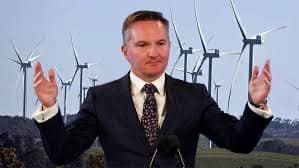
The Shift to Green Energy: Unveiling the Hidden Costs of Wind Turbines
The Independent
The shift to green energy has seen an exponential rise in the number of wind farms. Wind turbines now dot our landscapes, heralding the promise of a sustainable future. Yet, as compelling as this clean energy source is, it carries with it significant environmental challenges that are often overlooked.
Loss of Wildlife and Koala Habitat
One of the most pressing concerns associated with wind farms is the impact on wildlife. The construction of wind turbines often requires clearing vast areas of land, which leads to the destruction of natural habitats. In Australia, this has resulted in the loss of critical koala habitats. These iconic creatures, already under threat due to deforestation and urban development, now face an additional challenge from wind farm expansions. Disrupting their natural environment has a cascading effect on biodiversity, leading to a decline in various species that depend on these ecosystems.
Bird and Bat Mortality
Wind turbines are notorious for causing bird and bat mortality. The rotating blades, while a marvel of engineering, are a significant threat to avian life. Birds, particularly raptors and migratory species, often fall victim to these spinning giants. The disruption to bat populations is equally concerning, as they play a vital role in controlling insect populations and pollinating plants. The ecological imbalance caused by these fatalities can have long-term repercussions on local ecosystems.
Devastation of the Horizon
The visual impact of wind farms on the horizon is another contentious issue. In rural and coastal areas, where natural landscapes are cherished, the sight of towering wind turbines can be jarring. For many, these structures disrupt the natural beauty of the land and diminish the cultural and aesthetic value of the countryside. This visual pollution can also impact tourism, as visitors may be deterred by the industrial appearance of once-pristine landscapes.
Cost of Construction and Maintenance
The financial cost of constructing and maintaining wind turbines is substantial. Each turbine requires extensive groundwork, including the use of heavy machinery and large-scale construction operations. The ongoing maintenance, particularly in remote areas, adds to the overall cost. While proponents argue that wind energy is cost-effective in the long run, the initial investment and upkeep are significant financial burdens that cannot be ignored.
The Volume of Oil and Concrete Required
Despite being marketed as a green energy solution, wind turbines require large quantities of non-renewable resources during their construction. Each turbine contains several tonnes of steel, copper, and rare earth elements. Additionally, the volume of oil required for lubrication is significant. A typical wind turbine requires hundreds of gallons of oil annually to keep its components running smoothly. Furthermore, each turbine base is anchored by massive concrete foundations, often requiring over 1,000 tonnes of concrete per unit. The environmental footprint of producing and transporting these materials is considerable and contradicts the green narrative.
Reliance on Wind to Generate Power
The effectiveness of wind turbines is inherently tied to the availability of wind. While some regions experience consistent wind patterns, others do not, leading to intermittent energy generation. This reliance on weather conditions makes wind energy less reliable compared to traditional energy sources. To compensate for periods of low wind, backup energy solutions, often fossil-fuel-based, are required to maintain a steady power supply. This dependency undermines the goal of reducing carbon emissions and highlights the limitations of wind energy as a standalone solution.
Conclusion
While wind energy presents an opportunity to move away from fossil fuels, it is essential to acknowledge its environmental and economic drawbacks. The loss of wildlife habitats, bird mortality, visual impact, high construction costs, and reliance on non-renewable resources challenge the perception of wind turbines as a wholly green solution. As we transition towards a more sustainable future, it is crucial to balance renewable energy initiatives with the protection of our natural environment. A comprehensive approach that includes careful site selection, wildlife protection measures, and diversified energy sources will be necessary to achieve truly sustainable energy solutions.




